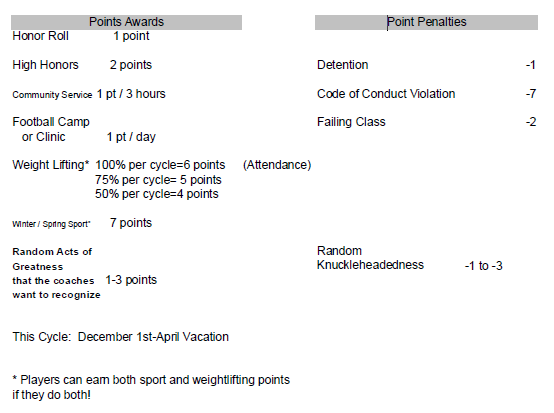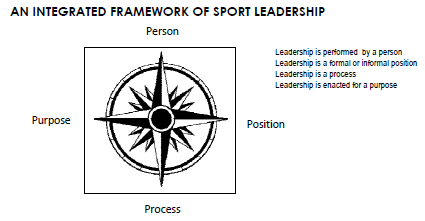The information presented here was provided to me by another coach and I know how important it is to develop our young athletes into leaders not only for the present but also for the future wanted to share this with you because it says so much that can help assist in developing a leadership academy in anyone’s athletic program.
Editor’s Note from Brian: The purpose of this post is not to say that you should copy this program as is. It has some aspects that are sport specific, but I feel there are many ideas that can be applied to any sport. You should take the ideas that you like and adapt them to fit what you think is best. It also can be scheduled when you are able to do it. The post is to give you ideas, not necessarily a blueprint.
Leadership Academy Purpose:
1. Raise awareness of the importance of quality leadership
2. Increase Leadership skills of athletes
3. Share the leadership workload
4. Develop the character of athletes
Value
Coaches often pin success on superb leadership; therefore, teams should not wait for leadership to cycle in on it’s own. Instead, like developing technique, strength, or speed, coaches should implement a plan for teaching and developing leadership skills in their players. Since captains and leaders spend much more time interacting with teammates than coaches, they can significantly impact the performance of a team. Thus, strong leadership will increase team production. Moreover, many competitions will create stressful situations for athletes. Building emotional and mental resiliency in athletes will help them to perform at their best despite high pressure situations. Finally, developing character and leadership in the school and in the community will improve the quality of life for all. Students, recognizing the virtue of high character, will be more apt to make ethical choices. Teachers will be better able to focus on teaching rather than behavior management, and coaches can worry less about losing players for conduct violations.
Meeting Schedules
The Leadership Academy will meet every two weeks for dinner, from 6:00pm to 7:30pm, at various players and coaches’ houses. The meeting day will vary in order to work around basketball, hokcey and track practices / competitions. Meetings will begin the second week of January and last until the last week in May. At these meetings, participants will discuss readings from Jeff Janssen’s Team Captain’s Leadership Manual, and also identify leadership and character weaknesses that the team should improve. From May to August, the Leadership group will meet once a month to discuss team issues or progress toward goals. During the season, they will meet once a week to discuss team moral, personnel issues, and logistical matters.
Curriculum
Week 1
The group will explore the concepts of leadership. By defining leadership, discussing the risks and
rewards of leadership positions, and reflecting on effective and ineffective leaders in the past, the group will establish a context from which to build new skills. In addition, players will self-evaluate their leadership as indicated by their commitment, confidence, composure, and character, as well as their ability to function as a servant, confidence builder, refocuser, team-builder and enforcer.
Week 2
The group will examine ways to motivate themselves. Participants will evaluate their own commitment level based on Janssen’s “Commitment Continuum” (Janssen, 29), as well as asses every team mate’s commitment level. The group will discuss why they placed each player at that place on the continuum and brainstorm ways to motivate players at the “resistant-reluctant-existent” (Janssen, 29) level.
Week 3
The group will explore the concept of confidence. Participants will look at confidence’s relationship with sense of self and the want to perform under pressure. We will discuss the four sources of confidence: preparation, strengths, past success, and praise, and also discuss ways to be resilient to events that threaten confidence.
Week 4
The group will learn to how maintain composure in pressure situations. Using a “traffic light analogy” (Janssen, 52), players will learn to recognize emotional states. In addition, we will discuss refocusing strategies like slowing the pace of play, controlling the controllable, and focusing on the present, the positive, and the process.
Week 5
The group will explore the concept of character. By discussing the importance of exhibiting character in the sport, in the classroom, in social life, and in the community, participants will raise their awareness of how their character establishes their credibility as leaders.
Week 6
The group will examine ways to function as servant leaders. In order to prevent leaders from becoming overbearing, we will discuss how helping younger players, preventing hazing, and completing day to day work creates a healthier team dynamic.
Week 7
The group will explore ways in which they can build the confidence of their team mates. Each squad leader will complete a “mental game assessment” (Janssen, 91) form on the players in their squad. As a group, we will discuss strategies for increasing the confidence and mental resilience of players. For example, leaders can let them know what to expect, remind them of their strengths, remind them of past successes, establish perspective, and encourage their teammates (Janssen, 93-94).
Week 8
The group will learn ways to refocus their teammates when faces with adversity. In essence, we will revisit the concepts from week 4, and discuss ways to teach others how to refocus.
Week 9
This week will focus in strategies for team building. We will revisit the team’s vision and mission statement, “clarify the commitments and standards” (Janssen, 112) necessary to achieve this vision, and discuss ways to help teammates accept their roles. In addition, we will brainstorm and create a teambuilding calendar to schedule events like an intersquad basketball tournament, a softball game, whitewater rafting trips, and team BBQ’s.
Week 10
This week will cover strategies for serving as the enforcer. We will address the reality that conflict is inevitable and that leaders must be prepared to handle it effectively. We will discuss approaches like encouraging first, then reminding and refocusing, then drawing the line, and, finally, involving the coach (Jansses, 126-127).
Squads
Purpose for squads:
1. Shared leadership amongst several instead of few. Share the load.
2. Provide more efficient methods of communication
3. Build stronger team relationships
4. Create healthy competition
5. Establish accountability for each other
Ways to earn points:
1. Successfully completing task (earning passing grades on quizzes, selling gold-cards, achieving set and measurable goals)
2. Winning competitions (Relay race, newspaper article, etc)
3. Citizenship (Community service…approved by one of the coaches)
4. Work ethic (Strength gain, measurable speed increase)
Ways to lose points: (and $1’s!)
1. Not completing required tasks (Team assignments, locker room cleanup) -1
2. Tardy -1
3. Unexcused absence -2
4. Violation of code of conduct -10
At the end of the season, the winning squad will finance a meal of their choice. The last place team will serve it to them!!

About the Author of this post:
Jerry Campbell has over 30 years of high school and college coaching experience. He has experience as a head coach, offensive coordinator, and various position coaches. He has written numerous football coaching articles in various publications, is the author of over 30 books on coaching football, and has produced 12 coaching video series. Additionally, he is a nationally sought after speaker on the coaching clinic circuit.


